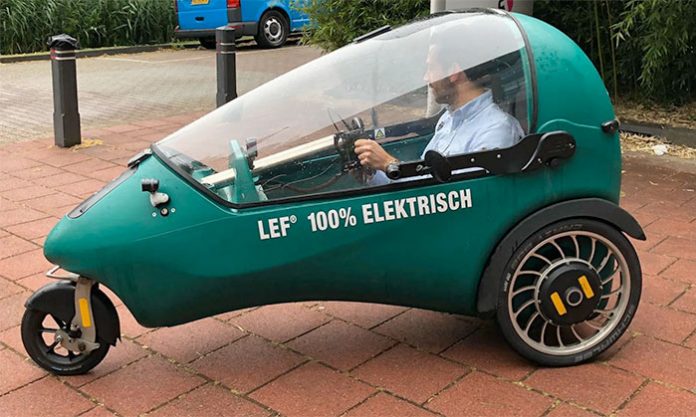
The evolution of electric vehicles continues to grow. As citizens of cities and towns come to find that having a car comes with many expenses and hassles, they are likely to seek alternatives. Bikes come to mind of course, but those hold their own disadvantages, even those of an electronic variety. People who generally only travel around their towns may feel that they simply cannot justify owning a full-on electric vehicle, but an e-bike is simply lacking in what they need.
Recognizing this gap in the market, the leaders of EV Mobility, Dutch designers Dave Goudeket and Erik Vegt, developed the LEF electric vehicle. While the vehicle has been around for almost three years, it has not yet garnered much attention outside its regional market. This is likely tied to the fact that the Netherlands has thus far been the lone nation having approved the recreational use of the LEF on public roads.
LEF Attributes
The LEF is powered by a 1000 watt motor, located in one of its rear wheels. This motor is powered by a 10 Ah, 48-volt lithium battery, one that can be charged via standard home outlets. A single charge achieves the ability to cover a 30 km (19 mi) range, but 20 or 30 Ah batteries can double or triple the scope of that range, respectively.
The LEF’s body is formulated from recyclable polyethylene. The vehicle can withstand a maximum weight of 200 kg (approximately 441 lbs). The vehicle itself weighs roughly 90 kg (198 lbs). The electric mini-vehicle can achieve speeds as high as 25 km/hour (16 miles/hour). Due to its relatively nominal speeds, it does not belong on the main road with other cars, but rather in a bike lane.
The LEF seats one driver/rider, with the sole resident of the cabin entering the vehicle by lifting the canopy, which is formed from a half elongated bubble-like window. Once inside, the driver pulls the steering mechanism, which is retracted into the front of the LEF out towards themselves, and then squeezes the throttle controls on the wheel in place of pedals to propel the LEF into forward motion. The steering mechanism can then be used to make wide turns by turning the routing front wheel (the vehicle’s smallest) to either the left or right.
Other Features
A cool feature of the LEF is its driver facing LCD screen. The screen displays drive-pertinent and vehicle relevant data that includes the distance traveled, charge levels, and current speed of the LEF.
LEF-Dutch-EV-Storage-Area
Accessing the storage area behind the LEF’s seat. EV Mobility
The LEF has been equipped with a 50-liter (13 gallons) cargo area in the rear of the vehicle’s seat. To access it, the driver may simply push the seat forward. The front dash includes USB ports for smartphone charges, as well as indicators for left and right turn signals. The vehicle is equipped with convenient and necessary front and rear LED lighting.
LEF even comes with some optional add-on features that include side mirrors for road travel and an electric windshield wiper, a necessary component for anyone who is likely caught driving the LEF in the middle of an unexpected rainstorm.
Who can drive the LEF and for how much?
The LEF comes with a starting price point of €4,380 (equivalent to roughly $5,309 US Dollars). At least in the Netherlands, a driver does not need to possess a driver’s license to operate the vehicle. This is because it is similar enough to a three-wheeled bike in that it does not require intricate road travel knowledge. The LEF is meant, as earlier mentioned, for bike lanes rather than open roads. The one requirement is that the drivers must be 16 years of age to operate the LEF.
As the electric vehicle market still remains in its infancy, it is bound to grow over the next few decades. Vehicles like the LEF electronic vehicle are already providing early solutions to the expenses of electronic vehicles and the openness but limited nature of bikes. As people begin to evaluate how much they actually need from the vehicles, and as governments realize their value in the marketing sphere, the LEF consumer base is bound to grow as the product will further mature and adapt to more regular uses outside of the Netherlands.

Startup
A startup or start-up is a company or project undertaken by an entrepreneur to seek, develop, and validate a scalable business model. While entrepreneurship refers to all new businesses, including self-employment and businesses that never intend to become registered, startups refer to new businesses that intend to grow large beyond the solo founder. At the beginning, startups face high uncertainty and have high rates of failure, but a minority of them do go on to be successful and influential. Some startups become unicorns; that is privately held startup companies valued at over US$1 billion.
Actions
Startups typically begin by a founder (solo-founder) or co-founders who have a way to solve a problem. The founder of a startup will begin market validation by problem interview, solution interview, and building a minimum viable product (MVP), i.e. a prototype, to develop and validate their business models. The startup process can take a long period of time (by some estimates, three years or longer), and hence sustaining effort is required. Over the long term, sustaining effort is especially challenging because of the high failure rates and uncertain outcomes. Having a business plan in place outlines what to do and how to plan and achieve an idea in the future. Typically, these plans outline the first 3 to 5 years of your business strategy.
Design principles
Models behind startups presenting as ventures are usually associated with design science. Design science uses design principles considered to be a coherent set of normative ideas and propositions to design and construct the company's backbone. For example, one of the initial design principles is "affordable loss".
- Log in to post comments